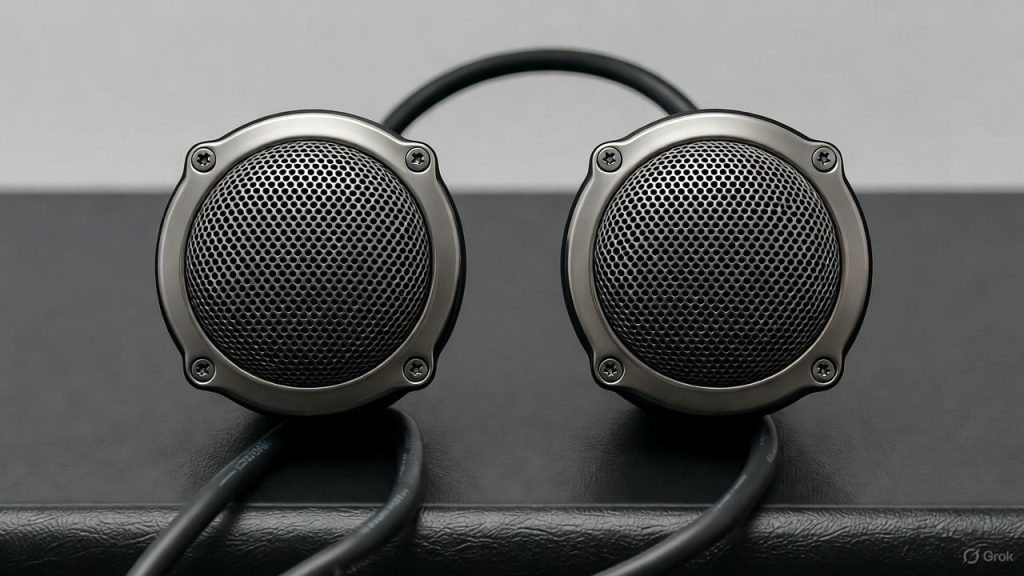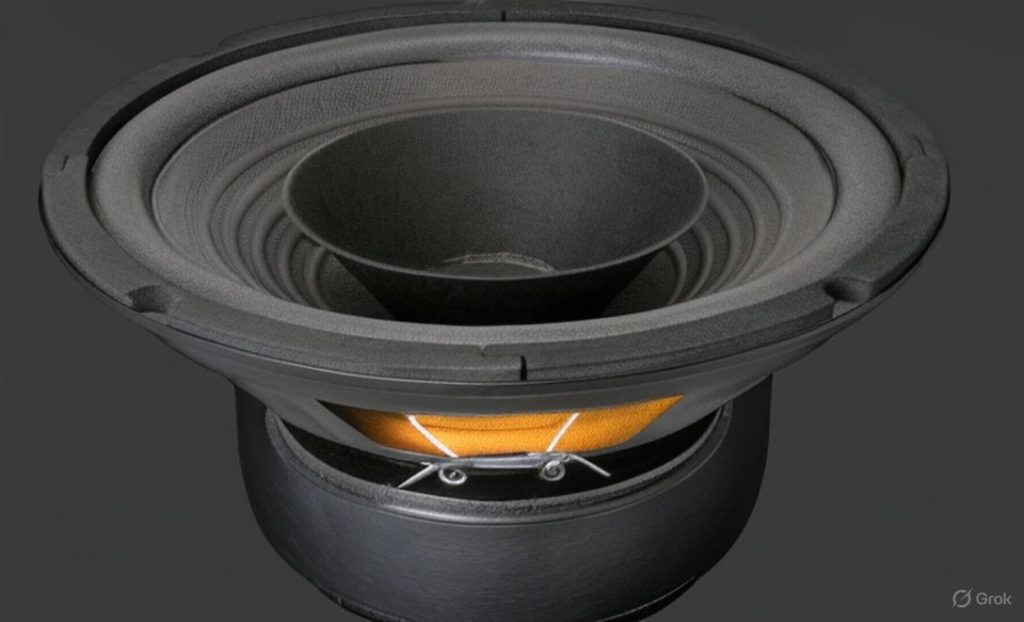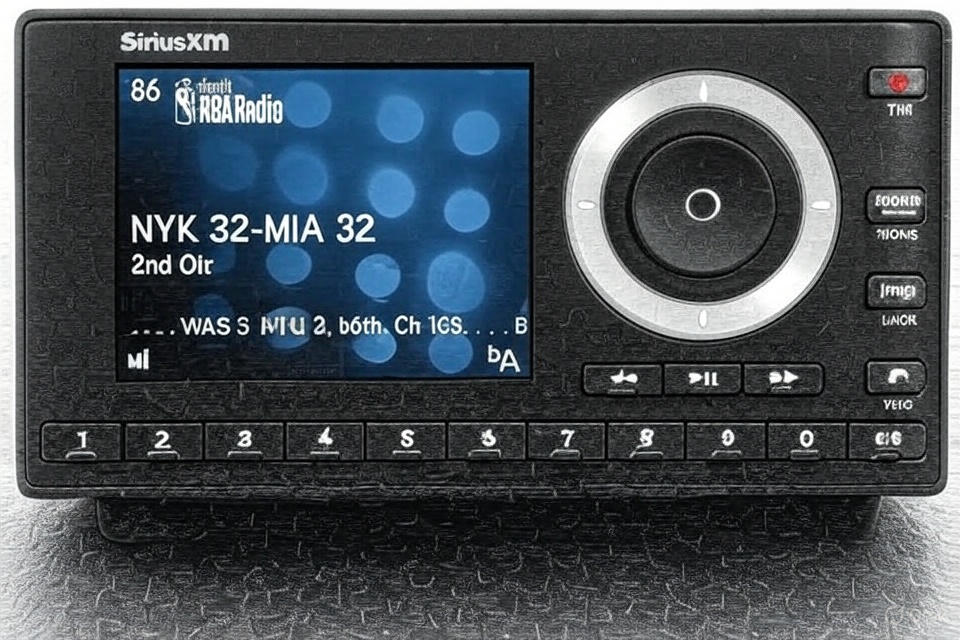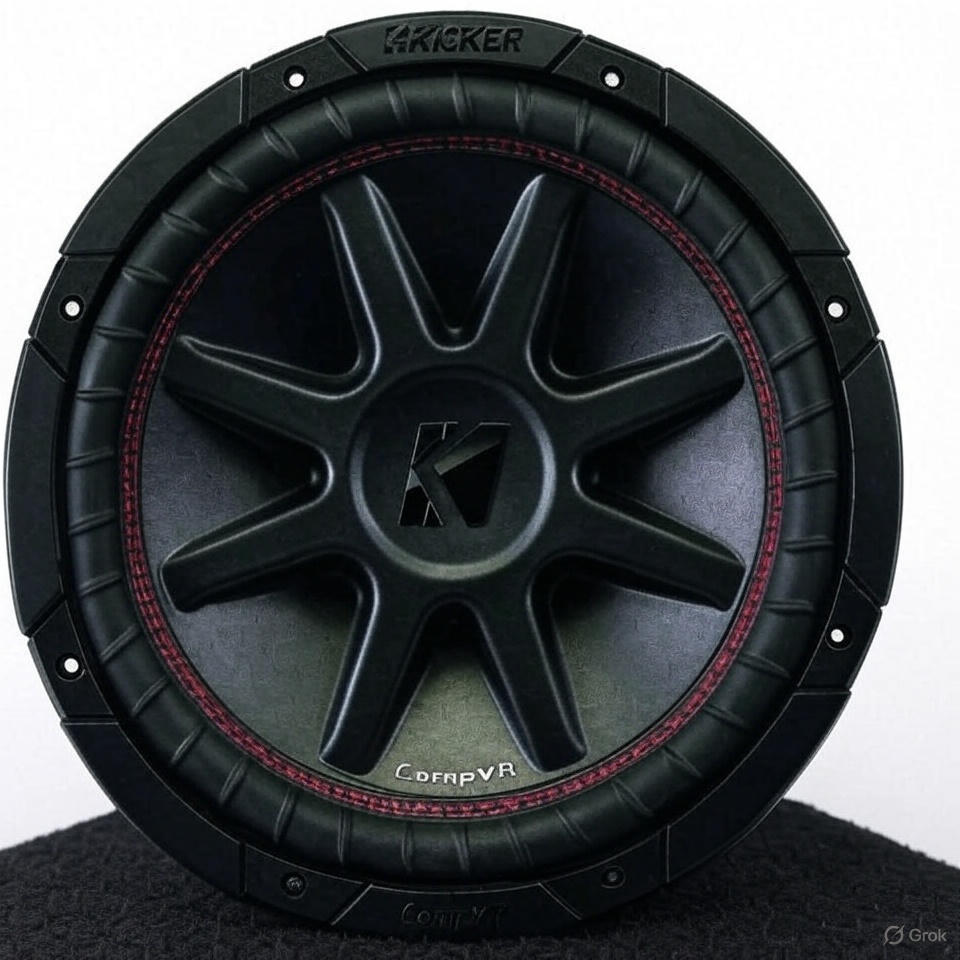Sound quality defines the audio experience in any car or home audio system. The high-frequency reproduction capabilities of your speakers determine how crisp and clear your music sounds. A quality 1 inch tweeter brings life to vocals, instruments, and subtle audio details that larger speakers often miss.
This comprehensive guide examines five exceptional 1 inch tweeters that deliver outstanding performance across different price points and applications. Each product has been evaluated based on power handling, sound clarity, build quality, installation ease, and overall value.
What Makes a Great 1 Inch Tweeter?
Before diving into specific products, understanding the key factors that separate premium tweeters from average ones helps make informed decisions. The dome material significantly impacts sound characteristics. Silk domes produce warm, smooth highs that many audiophiles prefer for extended listening sessions. Aluminum and titanium domes deliver crisp, detailed sound with excellent transient response.
Power handling capacity determines how loud your system can play without distortion. A tweeter rated at 240 watts max power differs substantially from one rated at 400 watts. The impedance rating, typically 4 ohms for car audio applications, affects compatibility with your amplifier and overall system design.
Sensitivity ratings tell you how efficiently a tweeter converts power into sound. Higher sensitivity means more volume with less power. This becomes crucial when pairing tweeters with factory head units or lower-powered amplifiers.
The magnet structure influences performance consistency and thermal management. Neodymium magnets offer superior magnetic strength in a compact, lightweight package. This design improves transient response and reduces overall weight.
Top 5 Best 1 Inch Tweeters Reviewed
1. Skar Audio TX-T 1-Inch 240 Watt Neodymium Silk Dome Tweeters
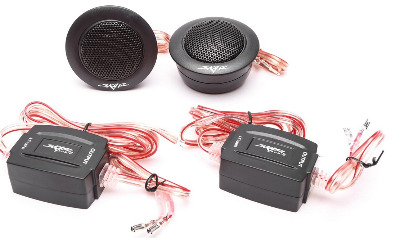
The Skar Audio TX-T series represents an excellent entry point for enthusiasts seeking quality sound without breaking the bank. These tweeters feature silk dome construction that produces smooth, natural highs. The soft dome material excels at reducing harshness and fatigue during long listening sessions.
Build Quality and Design
The neodymium magnet structure provides strong magnetic force while keeping weight low. This design choice enhances transient response, allowing the tweeter to accurately reproduce rapid changes in musical passages. The compact housing measures just over one inch, making installation straightforward in tight spaces.
Surface mounting becomes simple with the included mounting hardware. The flush-mount design integrates cleanly into door panels, sail panels, or dashboard locations. The black finish matches most interior color schemes without drawing unwanted attention.
Sound Performance
The silk dome delivers a warm, refined sound signature. Vocals come through with natural texture and presence. High-frequency instruments like cymbals and hi-hats sound realistic without excessive brightness. The 240-watt max power handling accommodates moderate to high volume levels without distress.
These tweeters work well with factory head units or aftermarket amplifiers rated between 50-100 watts RMS per channel. The 4-ohm impedance ensures compatibility with most car audio systems. Crossover points between 3.5kHz and 5kHz produce the best results, allowing the tweeter to focus on its optimal frequency range.
Practical Applications
The TX-T series suits daily drivers where sound quality matters more than maximum output. Music genres with prominent vocals and acoustic instruments benefit from the smooth silk dome character. Rock, jazz, classical, and pop recordings sound natural and engaging.
Installation typically takes 30-45 minutes for both tweeters when mounting in standard locations. The included wiring harness simplifies connections. Some users prefer adding external crossovers for more precise frequency control, though the tweeters perform adequately with passive crossovers built into component speaker sets.
Value Proposition
For budget-conscious audiophiles, these tweeters deliver impressive sound quality relative to their cost. The silk dome construction competes with products priced significantly higher. Durability proves solid with proper installation and reasonable power levels. The balanced sound signature appeals to listeners who prioritize musicality over aggressive detail.
2. Skar Audio TWS-01 1-Inch 240 Watt Neodymium Silk Dome Tweeters
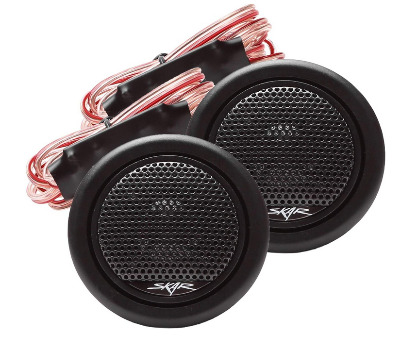
The TWS-01 model shares several characteristics with the TX-T series but incorporates refinements that enhance performance. The silk dome construction maintains the smooth, fatigue-free sound signature. Design improvements in the motor structure provide better power handling and thermal management.
Enhanced Motor Design
The upgraded neodymium magnet assembly generates stronger magnetic flux in the voice coil gap. This translates to improved efficiency and dynamic response. The tweeter produces more output with the same input power compared to standard designs. The voice coil uses high-temperature materials that resist thermal compression during demanding passages.
Ventilation channels in the motor structure allow heat dissipation. This prevents power compression that robs dynamics during high-volume listening. The result is consistent performance even during extended use at elevated levels.
Sonic Characteristics
The TWS-01 delivers refined highs with excellent detail retrieval. The silk dome produces natural treble extension without harshness. Female vocals sound particularly impressive, with subtle inflections and breathing clearly audible. String instruments like violins and acoustic guitars exhibit realistic timbre.
The extended frequency response reaches beyond 20kHz, capturing harmonic overtones that add air and space to recordings. Sound staging improves compared to factory speakers, with instruments appearing more precisely positioned across the listening area. Depth perception increases, creating a more three-dimensional presentation.
Installation Considerations
Mounting options include surface mounting and recessed installation. The included mounting cups accommodate both approaches. Surface mounting works well when space limitations prevent recessing. The tweeter sits proud of the mounting surface by approximately half an inch.
Recessed mounting provides a cleaner aesthetic and reduces the risk of physical damage. Many door panels and A-pillars have sufficient depth for flush mounting. The compact overall dimensions make finding suitable locations easier than with larger tweeters.
Wiring requires standard speaker wire, with 16-gauge or 18-gauge working well for most applications. Connection terminals accept bare wire or quick disconnects. Maintaining proper polarity ensures correct phase alignment with the rest of the speaker system.
Best Use Cases
These tweeters excel in systems emphasizing vocal clarity and natural tonality. Listeners who enjoy jazz, classical, acoustic, and vocal-focused music appreciate the refined presentation. The smooth character suits long highway drives and daily commutes where listening fatigue becomes a concern.
Pairing with quality midrange drivers creates a balanced component speaker system. The tweeters complement silk or paper cone midranges particularly well, maintaining consistent tonal character across the frequency spectrum. Amplifier power between 60-120 watts RMS per channel brings out the best performance.
3. DS18 PRO-TWX1 Super Tweeter with Built-in Crossover
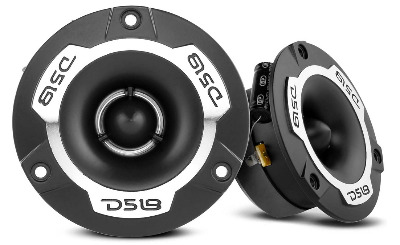
The DS18 PRO-TWX1 takes a different approach with aluminum construction throughout. The aluminum frame and diaphragm deliver crisp, detailed sound with emphasis on clarity and precision. The built-in crossover simplifies installation by eliminating the need for external components.
Aluminum Construction Benefits
Aluminum domes respond quickly to electrical signals due to low mass and high stiffness. This characteristic makes them ideal for reproducing transient sounds like cymbal strikes and snare drum hits. The material resists breakup at high frequencies, maintaining clean output up to the tweeter’s upper limit.
The aluminum frame provides structural rigidity and effective heat dissipation. The frame design includes mounting holes that accept various installation methods. The robust construction handles vibration and physical stress better than plastic housings.
Integrated Crossover Advantage
The built-in crossover network filters out low frequencies that could damage the tweeter. This protection extends component life and prevents distortion from over-excursion. The crossover point sits at approximately 4kHz, a common frequency for separating tweeter and midrange duties.
Having the crossover integrated into the tweeter housing reduces installation complexity. No external crossover box needs mounting, saving space and reducing potential failure points. The simplified wiring requires only speaker-level inputs from the amplifier or head unit.
Sound Profile
The aluminum dome produces bright, energetic highs with excellent articulation. Every detail in the recording comes through with clarity. This characteristic benefits listeners who prefer analytical sound that reveals recording quality and production techniques. Electronic music, rock, and modern pop recordings showcase the tweeter’s capabilities.
The sound signature emphasizes the upper midrange and lower treble region. This tuning brings vocals forward in the mix and highlights guitar and keyboard parts. Some listeners find the presentation slightly aggressive compared to silk domes, though this quality appeals to those seeking maximum detail and presence.
Power Handling and Sensitivity
The 240-watt max power rating allows high-volume playback without strain. The tweeter handles dynamic peaks in music without compression or distortion. Sensitivity measures higher than average, producing substantial output from moderate power levels. This efficiency works well with factory amplifiers or entry-level aftermarket units.
The 4-ohm impedance maintains compatibility with most car audio systems. When installing pairs, total impedance remains at 4 ohms with parallel wiring or increases to 16 ohms with series wiring. Parallel wiring works best for maximum output.
Installation Tips
The aluminum construction requires secure mounting to prevent resonance. Tight mounting screws ensure the tweeter remains firmly attached during vehicle operation. Using the included gaskets creates a proper seal between the tweeter and mounting surface.
Aim tweeters toward listening positions for optimal sound staging and imaging. Installing in door panels or sail panels with slight angle toward ear level produces the best results. Avoid pointing tweeters directly at hard surfaces that create reflections and comb filtering.
4. Skar Audio SPX-T 1-Inch 320 Watt Elite Neodymium Aluminum Dome Tweeters
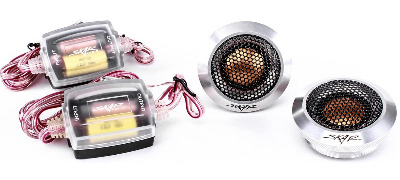
The SPX-T represents Skar Audio’s premium offering in the 1-inch category. The aluminum dome construction delivers detailed, dynamic sound. The higher 320-watt power rating accommodates more powerful amplifiers and higher listening levels.
Elite-Level Components
The neodymium magnet structure uses higher-grade materials than standard offerings. The stronger magnetic field improves control over the voice coil, enhancing transient response and reducing distortion. The voice coil itself uses materials rated for higher temperatures, preventing thermal failure during demanding use.
The aluminum dome features advanced forming techniques that improve rigidity and reduce resonance. The dome profile optimizes dispersion characteristics, creating a wider sweet spot. More listeners in the vehicle experience high-quality sound rather than just the person in the ideal listening position.
Enhanced Power Handling
The 320-watt maximum power rating provides headroom for dynamic peaks in music. The tweeter handles sudden loud passages without strain, maintaining clean output. The 160-watt RMS rating indicates continuous power handling capacity. This specification matters more for real-world performance since amplifiers deliver continuous power during normal listening.
The improved thermal management prevents power compression. Many tweeters lose output as they heat up, requiring increased volume to maintain perceived loudness. The SPX-T maintains consistent performance across extended listening sessions at high volume.
Detailed Sound Reproduction
The aluminum dome excels at revealing fine details in recordings. Subtle percussion instruments, ambient sounds, and reverb tails come through clearly. This level of detail benefits listeners who enjoy analyzing recordings and appreciating production quality.
The extended frequency response reaches the limits of human hearing. Harmonic overtones and air around instruments create a sense of space and realism. Sound staging expands beyond the physical dimensions of the vehicle, placing instruments and voices in distinct locations.
Vocal reproduction maintains clarity without sibilance or harshness. The tweeter handles complex passages with multiple overlapping sounds without smearing or confusion. Each element remains distinct and identifiable.
System Integration
These tweeters pair well with high-quality component speaker systems. The performance capabilities match premium midrange drivers that can keep up with the tweeter’s resolution. Amplifier power between 100-200 watts RMS per channel brings out peak performance.
Active crossovers provide optimal results by precisely controlling frequency division and phase alignment. Digital signal processors allow fine-tuning of crossover points, slopes, and time alignment. This level of control maximizes the tweeter’s capabilities.
Passive crossovers work adequately when using quality components with appropriate values. Crossover points between 3kHz and 4.5kHz prevent overlap with midrange drivers while protecting the tweeter from low-frequency content.
Target Audience
Sound quality enthusiasts who demand top-tier performance gravitate toward these tweeters. The combination of power handling, detail retrieval, and build quality justifies the premium price. Installation in high-end systems with quality amplification and source components showcases the SPX-T’s abilities.
Competition-level systems benefit from the higher power handling and efficiency. The tweeters produce substantial output needed for sound quality competitions where volume and clarity both matter. The aluminum construction withstands the vibration and stress of competition use.
5. RECOIL TW250 High Compression Bullet Super Tweeters
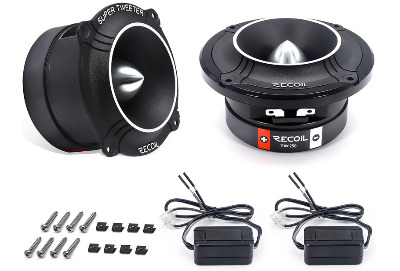
The RECOIL TW250 introduces bullet super tweeter design to the lineup. The distinctive appearance and construction method differentiate this product from conventional dome tweeters. The high compression design produces extreme output levels with excellent efficiency.
Bullet Tweeter Design Explained
Bullet tweeters use a horn-loaded design that increases acoustic output through mechanical amplification. The compression driver sits behind an exponential horn that transforms high-pressure, low-velocity sound waves into low-pressure, high-velocity waves. This conversion dramatically increases efficiency.
The horn shape determines dispersion pattern and frequency response. The TW250 uses a design optimized for wide dispersion, preventing the narrow beam often associated with bullet tweeters. The result is usable coverage across a larger listening area.
Kapton Voice Coil Technology
The voice coil uses Kapton, a high-temperature polymer material developed for aerospace applications. Kapton maintains mechanical and electrical properties at temperatures exceeding 400 degrees Celsius. This thermal stability prevents voice coil failure during extreme use.
The 1-inch voice coil diameter provides excellent power handling. Larger voice coils dissipate heat more effectively and handle higher power levels without damage. The combination of Kapton material and generous diameter creates a tweeter capable of withstanding abuse that would destroy conventional designs.
Extreme Power Handling
The 400-watt maximum power rating dwarfs other tweeters in this comparison. The 200-watt RMS rating indicates serious continuous power handling capability. These specifications suit powerful amplifiers and high-volume listening.
The sensitivity rating exceeds most dome tweeters by several decibels. This means the TW250 produces significantly more volume with the same input power. The efficiency benefits listeners using factory head units or moderate amplifier power who still want high output.
Sound Characteristics
The compression design produces extremely crisp, detailed highs with forward presentation. The sound signature emphasizes presence and energy. This character suits music genres that benefit from aggressive treble, including rock, metal, electronic dance music, and hip-hop.
The bullet design excels at cutting through background noise and competing sounds. This makes the TW250 ideal for vehicles with significant road noise or open-top designs like convertibles and motorcycles. The sound projects effectively even in challenging acoustic environments.
Some listeners find the forward presentation fatiguing during extended listening sessions. The emphasis on detail and presence works better for shorter drives or situations where maximum impact matters more than long-term comfort.
Installation Requirements
The bullet design requires different mounting considerations than dome tweeters. The depth from mounting surface to rear of the housing measures approximately 2.5 inches. Adequate clearance must exist behind the mounting location. Surface mounting often works better than recessed installation.
The weight exceeds dome tweeters due to the compression driver and metal housing. Secure mounting prevents movement and potential damage. The included mounting hardware accommodates most installation scenarios. Some users fabricate custom mounting brackets for specific locations.
Wiring follows standard practices with 4-ohm impedance matching most systems. The power handling capability requires adequate wire gauge to prevent voltage drop and overheating. 14-gauge or 16-gauge wire works well for most installations.
Ideal Applications
These super tweeters shine in high-output systems where maximum volume matters. Sound pressure level competitions benefit from the extreme efficiency and power handling. The tweeter produces attention-grabbing output that commands notice.
Vehicles with significant background noise find the forward presentation advantageous. The sound cuts through wind noise, tire rumble, and exhaust sounds. Motorcycles, boats, and off-road vehicles represent ideal applications where competing sounds challenge conventional tweeters.
Listeners who prefer energetic, exciting sound over neutral accuracy appreciate the TW250’s character. The presentation brings energy and excitement to recordings. This suits driving situations where engagement and impact enhance the experience.
How to Install 1 Inch Tweeters Properly
Proper installation determines whether tweeters perform to their potential. Poor installation compromises sound quality regardless of component quality. Following proven techniques ensures optimal results.
Location Selection
Tweeter placement affects sound staging, imaging, and overall tonal balance. High-frequency sounds are directional, so aim matters significantly. Mounting tweeters at or near ear level provides the most natural presentation. This positions high frequencies on-axis with listeners’ ears.
Common mounting locations include A-pillars, sail panels, door panels, and dashboard corners. Each location offers advantages and compromises. A-pillar mounting typically provides the best imaging and sound stage depth. The tweeters sit close to ear level with direct path to listeners.
Door panel mounting offers easier installation but potentially compromises imaging. The lower position places tweeters off-axis, affecting high-frequency perception. Angling tweeters upward compensates partially for the lower position.
Aiming and Angling
Tweeters should aim toward the primary listening position. For driver-focused systems, angle both tweeters toward the driver’s head position. For balanced systems, aim each tweeter toward the opposite side’s occupant. This creates a central image where both channels converge.
Small adjustments in aim produce noticeable changes in sound character. Experimenting with different angles helps find the optimal position. Many installers use protractor tools and laser pointers to calculate precise angles.
Wiring Best Practices
Use quality speaker wire with appropriate gauge for the power level. Thinner wire creates resistance that reduces power delivery and potentially overheats. Secure connections prevent intermittent operation and signal degradation. Soldered connections provide the most reliable interface, though quality crimp connectors work well.
Maintain proper polarity throughout the system. Reversed polarity causes phase cancellation that destroys sound quality. Testing polarity with a battery and observing cone movement verifies correct connections before permanent installation.
Route wiring away from noise sources including power cables, ignition systems, and electrical motors. Noise interference manifests as whining, buzzing, or static in audio playback. Proper routing and shielding prevent these issues.
Crossover Configuration
Crossover points determine which frequencies reach each speaker. Setting tweeter crossover points too low allows damaging bass frequencies through while setting them too high creates gaps in frequency response. Start with manufacturer recommendations and adjust based on listening tests.
Crossover slope affects overlap between tweeter and midrange. Steeper slopes create more defined separation while gentler slopes produce smoother transition. Most installations benefit from 12dB or 18dB per octave slopes.
Active crossovers provide precise control and adjustment capability. Digital signal processors offer parametric equalization, time alignment, and level matching. These tools help compensate for acoustic challenges in automotive environments.
Factors to Consider Before Buying
Making an informed purchase decision requires evaluating several factors beyond just sound quality. Understanding these elements prevents mismatched components and disappointing results.
Power Matching
Tweeter power handling must align with amplifier output. Underpowered tweeters distort and fail when driven hard. Overpowered tweeters lack impact and fail to utilize available amplifier capacity. Match RMS ratings for continuous power handling rather than peak ratings.
Consider the entire system’s power balance. Tweeters, midranges, and woofers should receive proportional power. Imbalanced power distribution creates tonal imbalance with some frequencies overwhelming others.
Impedance Compatibility
Speaker impedance affects how amplifiers deliver power and control drivers. Mismatched impedance can damage amplifiers or produce poor sound quality. Most car audio amplifiers work best with 4-ohm loads. Check amplifier specifications to verify compatibility.
Installing multiple tweeters affects total system impedance. Parallel wiring reduces impedance while series wiring increases it. Calculate total impedance to ensure amplifier compatibility and optimal power transfer.
Sensitivity Ratings
Sensitivity indicates how efficiently speakers convert power into sound. Higher sensitivity produces more volume with less power. This specification matters when using factory amplifiers or lower-powered aftermarket units. Sensitive tweeters produce satisfying volume with modest power.
Match tweeter sensitivity with midrange sensitivity for balanced output. Significant sensitivity mismatches create tonal imbalance requiring attenuation of the more sensitive driver. This wastes amplifier power and reduces overall system efficiency.
Tonal Preferences
Personal taste plays a huge role in satisfaction with any audio component. Silk dome tweeters produce warm, smooth sound that many find less fatiguing. Aluminum and titanium domes deliver crisp detail and analytical presentation. Neither approach is objectively better; preference determines the right choice.
Consider primary music genres and listening habits. Acoustic and vocal music benefits from smooth, natural presentation. Electronic, rock, and pop music often sounds more engaging with detailed, energetic presentation. Match tweeter character with musical preferences.
Budget Considerations
Quality audio equipment exists at various price points. Higher prices generally deliver better performance, but diminishing returns occur. Entry-level tweeters provide excellent value for budget-conscious buyers. Premium options satisfy demanding enthusiasts seeking ultimate performance.
Consider the entire system budget. Spending disproportionately on one component creates bottlenecks where cheaper components limit performance. Balance component quality across the system for optimal results.
Maintenance and Care Tips
Proper maintenance extends tweeter life and maintains performance. Simple precautions prevent damage and preserve sound quality over time.
Volume Management
Playing audio at excessive volume damages tweeters through overheating and mechanical failure. Distortion indicates the amplifier or speaker has reached its limit. Reduce volume immediately when distortion becomes audible. Clean, undistorted playback preserves components and sounds better.
Dynamic recordings contain passages that suddenly increase in volume. These peaks can exceed tweeter capabilities even when average volume seems reasonable. Leave headroom in volume settings to accommodate dynamic peaks without distress.
Cleaning and Protection
Dust and debris accumulate on speaker domes over time. This contamination dampens high-frequency response and potentially damages delicate voice coils. Gentle cleaning with compressed air removes loose particles without physical contact that could damage domes.
Protect tweeters from moisture and humidity when possible. While most tweeters handle moderate moisture exposure, excessive wetness damages voice coils and suspensions. Cover or remove tweeters when washing vehicles or detailing interiors.
Electrical Protection
Use proper fusing to protect tweeters and amplifiers from catastrophic failure. Fuses provide inexpensive insurance against damaged components. Place fuses near power source and size them appropriately for the circuit.
Turn off or lower volume before starting vehicles. Some electrical systems produce voltage spikes during starting that can damage audio components. This precaution prevents transient voltage from reaching speakers.
Inspect connections periodically for corrosion and looseness. Corroded connections increase resistance and reduce performance. Clean terminals and apply contact enhancer to prevent corrosion.
Comparing Silk Dome vs Aluminum Dome Technology
The two primary dome materials used in these tweeters offer distinct characteristics. Understanding the differences helps match tweeter type with preferences and applications.
Silk Dome Characteristics
Silk domes use fabric material that produces smooth, natural high frequencies. The material damps internal resonances that cause harshness and coloration. This damping creates a relaxed sound that remains pleasant during extended listening.
The soft material responds gently to transient sounds. This characteristic prevents excessive emphasis on sharp, sudden sounds like cymbals and percussion. Some listeners prefer this gentler presentation while others find it lacks impact.
Silk domes typically exhibit wider dispersion than rigid materials. The flexible nature prevents narrow beaming that concentrates sound in small areas. Wider dispersion creates a larger sweet spot where listeners experience quality sound.
Aluminum Dome Advantages
Aluminum domes deliver crisp, detailed reproduction with excellent transient response. The rigid material accelerates and decelerates quickly, accurately following electrical signals. This precision reveals subtle details in recordings.
The lightweight, stiff construction extends frequency response higher than silk domes. Extended response captures ultrasonic harmonics that add air and space to the presentation. Some argue humans cannot hear these frequencies, though many detect differences in overall sound character.
Aluminum withstands higher power levels than silk without mechanical failure. The material’s strength allows aggressive playback without damage. This durability suits high-power systems and demanding listening conditions.
Application Recommendations
Choose silk domes for systems emphasizing natural tonality and listening comfort. Jazz, classical, acoustic, and vocal recordings benefit from the refined presentation. Long commutes and extended listening sessions favor the fatigue-free character.
Select aluminum domes for systems prioritizing detail and analytical sound. Electronic music, rock, metal, and modern pop recordings showcase the crisp presentation. Installations in noisy environments benefit from the forward character that cuts through competing sounds.
Troubleshooting Common Tweeter Issues
Problems with tweeters manifest in various ways. Identifying and resolving these issues restores proper operation and sound quality.
No Sound Output
Complete silence from tweeters indicates electrical or mechanical failure. Check connections first, as loose or corroded terminals frequently cause this symptom. Tighten connections and clean terminals to restore contact.
Test tweeter operation by connecting directly to known working amplifier output. If sound returns, the problem lies in wiring or crossover components. If silence persists, the tweeter itself has failed internally.
Blown fuses in crossover networks interrupt power to tweeters. Locate and test fuses, replacing any that have opened. Determine why the fuse blew before operation to prevent repeat failure.
Distorted Sound
Distortion from tweeters results from several causes. Excessive power causes voice coil overheating and mechanical over-excursion. Both conditions produce audible distortion. Reduce volume to eliminate distortion from overdriving.
Incorrect crossover points allow low frequencies into tweeters that cannot reproduce them. The tweeter attempts to move farther than physically possible, creating distortion. Adjust crossover points higher to filter these frequencies.
Damaged voice coils produce distortion at any volume level. Physical damage or separation from the dome creates irregular movement. This condition requires tweeter replacement.
Reduced Output
Tweeters gradually losing volume indicate power or efficiency problems. Corroded connections increase resistance, reducing power delivery. Clean terminals and connections to restore proper operation.
Voice coil damage from overheating changes electrical characteristics and reduces efficiency. Partially damaged coils operate but produce less output. This condition worsens over time, eventually causing complete failure.
Crossover component degradation affects output level. Capacitors and inductors change value with age, altering frequency response and reducing tweeter level. Replace crossover components to restore proper operation.
Rattling or Buzzing
Loose mounting hardware creates rattles transmitted through the tweeter housing. Tighten all mounting screws and verify secure attachment. Use thread-locking compound to prevent screws from loosening through vibration.
Debris inside the tweeter gap between voice coil and magnet causes buzzing. This foreign material interferes with proper voice coil movement. Professional service can remove debris, though replacement often proves more practical.
Damaged dome material produces buzzing from irregular movement. Tears or holes in silk domes create this symptom. Aluminum domes rarely tear but can separate from voice coil. Either condition requires replacement.
Maximizing Sound Quality Through System Tuning
Even excellent tweeters require proper tuning to achieve peak performance. System adjustments optimize response and create balanced, engaging sound.
Time Alignment Basics
Sound travels at approximately 1130 feet per second. Different distances from speakers to listeners create timing differences that blur imaging. Time alignment delays closer speakers to synchronize arrival times.
Measure distance from each speaker to the primary listening position. Calculate delay required for closer speakers to compensate for distance differences. Many amplifiers and digital signal processors include delay adjustment.
Proper time alignment creates focused imaging where instruments and voices appear in specific locations. The sound stage gains depth and realism. Vocals center precisely while instruments spread naturally across the stage.
Equalization Techniques
Automotive environments create acoustic challenges that equalization helps overcome. Frequency response measurements identify peaks and dips requiring correction. Apply equalization to flatten response and restore natural tonal balance.
Target a gently sloping response that mimics natural hearing characteristics. Perfectly flat response often sounds bright and fatiguing. Subtle roll-off above 10kHz creates more natural, pleasant sound.
Avoid excessive equalization boost that wastes amplifier power and risks driver damage. Cut problematic frequencies rather than boosting deficient ones when possible. This approach preserves dynamic range and prevents distortion.
Level Matching
Balance output levels between tweeters and midranges for coherent sound. Mismatched levels create tonal imbalance where certain frequencies overwhelm others. Use amplifier gain controls or digital signal processor level adjustment.
Play reference recordings with natural tonal balance. Adjust levels until all frequencies appear equally present. Vocals should sound clear without excessive brightness or dullness. Instruments should appear realistic without emphasis.
Test various recordings spanning different genres. Proper balance works across diverse material without requiring adjustment. Poor balance requires volume changes between songs or sounds good with some material but poor with others.
Real-World Performance Expectations
Understanding realistic performance expectations prevents disappointment and guides appropriate product selection. Even excellent tweeters have limitations based on physics and design compromises.
Volume Capabilities
Each tweeter has maximum output limits determined by power handling and excursion limits. Attempting to exceed these limits causes distortion and potential damage. Accept that small tweeters cannot produce stadium-level volume regardless of amplifier power.
Realistic expectations place tweeter output sufficient for typical listening in vehicles. Background music, engaged listening, and spirited playback all work within tweeter capabilities. Extreme volume requires multiple speakers and substantial amplifier power.
Frequency Response Reality
Manufacturers specify frequency response ranges that appear impressive on paper. Real-world response includes peaks, dips, and irregularities from acoustic environment and installation variables. Perfect flat response proves impossible in typical installations.
Focus on overall tonal character rather than specification sheet claims. Listen to actual performance in realistic conditions. Well-designed tweeters sound good despite imperfect measurements because engineers tune for subjective satisfaction.
Durability Factors
Quality tweeters last many times when properly used. Reasonable volume levels, adequate power, and protected installation extend service life indefinitely. Abuse through excessive volume or improper installation causes premature failure.
Expect periodic maintenance including cleaning and connection inspection. Component replacement becomes necessary when performance degrades or failure occurs. Budget systems require more frequent attention than premium components.
Environmental Considerations for Tweeter Selection
Operating environment significantly impacts tweeter performance and longevity. Different conditions require specific features and construction methods.
Temperature Extremes
Vehicles parked in direct sunlight reach interior temperatures exceeding 150 degrees Fahrenheit. This heat stresses tweeter components including voice coils, adhesives, and suspension materials. Quality tweeters use materials rated for automotive temperature extremes.
Cold temperatures below freezing make some materials brittle and reduce flexibility. Suspension materials must remain compliant across temperature ranges. Neodymium magnets maintain magnetic strength better than ceramic magnets in cold conditions.
Humidity and Moisture
Coastal areas and humid climates expose tweeters to moisture that damages electrical components and corrodes metal parts. Sealed designs with moisture-resistant materials last longer in these conditions. Aluminum domes resist moisture better than silk domes that can develop mold.
Convertibles and open vehicles expose tweeters directly to precipitation. Consider weather-resistant designs or protective covers for installations in exposed locations. Marine-grade components handle moisture exposure better than standard car audio tweeters.
Vibration and Shock
Vehicles with stiff suspension or those driven on rough roads subject audio components to significant vibration and shock. Secure mounting prevents physical damage and maintains proper operation. Robust construction withstands these forces better than fragile designs.
Off-road vehicles and motorcycles generate extreme vibration that can damage delicate components. The RECOIL bullet design with metal construction handles these conditions better than conventional dome tweeters with lightweight materials.
Integration with Existing Audio Systems
New tweeters must work harmoniously with existing components for optimal results. Consider compatibility factors before purchase.
Factory System Upgrades
Replacing factory tweeters with aftermarket units improves sound quality dramatically. Factory tweeters typically use inexpensive materials and minimal power handling. Aftermarket tweeters offer superior performance even with factory amplification.
Verify physical dimensions match factory tweeter locations. Mounting holes, diameter, and depth must accommodate new tweeters. The Skar Audio models typically fit factory locations with minimal modification.
Factory crossovers work with most aftermarket tweeters, though performance improves with upgraded networks. The DS18 with built-in crossover simplifies integration by eliminating dependence on factory components.
Component Speaker Systems
Many aftermarket speakers come as component systems with matched tweeters and midranges. Replacing just tweeters from these systems requires impedance and sensitivity matching. Significant mismatches create tonal imbalance.
The SPX-T works well in premium component systems where quality midranges complement the tweeter’s capabilities. Pairing with entry-level midranges creates bottlenecks where less capable components limit overall system performance.
Multi-Way Active Systems
Advanced installations use active crossovers and multiple amplifier channels for precise control. These systems accommodate various tweeter types with proper tuning. Digital signal processors provide tools needed to integrate any quality tweeter successfully.
Active systems allow fine-tuning of crossover points, slopes, levels, and delays. This flexibility maximizes each component’s strengths while minimizing weaknesses. The investment in processing equipment justifies premium tweeters like the SPX-T that respond to careful tuning.
Making the Final Decision
Selecting the right 1 inch tweeter depends on balancing multiple factors including budget, sound preferences, power requirements, and intended use.
Budget-Focused Selection
The Skar Audio TX-T delivers excellent value for cost-conscious buyers. The silk dome produces pleasant sound that competes with more expensive options. The 240-watt power handling accommodates most systems without requiring premium amplification.
The TWS-01 represents a step up with improved motor design and thermal management. The modest price increase brings noticeable performance gains. This option suits buyers wanting better sound without jumping to premium pricing.
Performance-Oriented Choice
Enthusiasts prioritizing sound quality benefit from the SPX-T’s advanced construction and higher power handling. The aluminum dome reveals details that lesser tweeters miss. The 320-watt rating accommodates powerful amplifiers without strain.
Pairing these tweeters with quality source components and amplification reveals their full potential. The investment pays dividends in listening satisfaction and long-term reliability. Systems built around premium components justify the higher cost.
Maximum Output Applications
The RECOIL TW250 dominates when extreme volume matters most. The 400-watt power handling and high compression design produce output levels impossible from conventional dome tweeters. The efficiency means loud playback without massive amplifier power.
Sound pressure level competitions and high-noise environments benefit from the bullet design’s characteristics. The forward presentation cuts through competing sounds effectively. Accept the potentially fatiguing sound signature as a trade-off for maximum impact.
Balanced Sound Preference
Listeners valuing natural tonality and listening comfort prefer silk dome designs. The TX-T and TWS-01 both deliver smooth, refined highs without harshness. Extended listening sessions remain enjoyable without fatigue.
These tweeters suit acoustic music, jazz, classical, and vocal-focused recordings. The warm character complements these genres beautifully. Rock and pop sound good too, though enthusiasts seeking maximum detail might prefer aluminum domes.
Detail-Focused Listening
The DS18 PRO-TWX1 and SPX-T both offer crisp, detailed sound through aluminum construction. Every nuance in recordings comes through clearly. This analytical presentation appeals to listeners who enjoy dissecting music and appreciating production quality.
Electronic music, modern pop, and rock recordings benefit from the energetic presentation. The forward character brings excitement and engagement. The built-in crossover in the DS18 simplifies installation for DIY enthusiasts.
